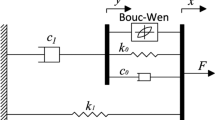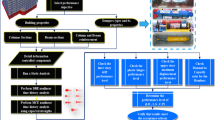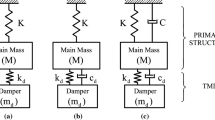Abstract
This paper presents a useful approach to optimally design magnetorheological (MR) dampers used in structural buildings. To fulfill this aim, damper parameters are regarded as the design variables whose values can be obtained through an optimization process. To improve the quality of searching for the optimum parameters of MR dampers, charged system search (CSS) and grey wolf (GW) algorithms, two of the most widely utilized meta-heuristic algorithms, are used together, and hybrid CSS-GW is presented. To show the authenticity and robustness of the new algorithm in solving optimization problems, some benchmark test functions are tested, at first. Then, an eleven-story benchmark building equipped with 3 MR dampers is considered to get the optimum design of the MR damper using the hybrid CSS-GW. Results show that the developed hybrid algorithm can successfully figure out the optimum parameters of the MR dampers.
Similar content being viewed by others
Abbreviations
- A, B, C, D, and h :
-
State matrixes of the system
- \(\overrightarrow{A}\;\rm{and}\;\overrightarrow{C}\) :
-
Coefficient vectors in the GWO
- \(\mathcal{C}\) :
-
Damping system matrix
- c 0 :
-
Viscous damping of the MR damper at high velocities
- c 1 :
-
Viscous damping of the MR damper at low velocities
- \(\left\| {d_i^c(t)} \right\|\) :
-
Norm drift of the controlled building
- \(\left\| {d_i^u(t)} \right\|\) :
-
Norm drift of the uncontrolled building
- E̓ :
-
Vector of ones
- F j :
-
Resultant force acting on the jth charged particle
- F(t):
-
Control force
- \(\mathcal{K}\) :
-
Stiffness system matrix
- k a :
-
Acceleration coefficients of the CSS algorithm
- k v :
-
Velocity coefficients of the CSS algorithm
- k 0 :
-
Stiffness of the MR damper at high velocities
- k 1 :
-
Accumulator stiffness of the MR damper
- m :
-
Number of control devices
- \(\mathcal{M}\) :
-
Mass system matrix
- n :
-
Number of degrees of freedoms
- N :
-
total number of charged particles
- p ij :
-
Probability of moving each CP towards the others
- q i :
-
Magnitude of the charge for each CP in CSS
- r ij :
-
separation distance between any two charged particle
- rand j :
-
random number uniformly distributed in the range (0,1)
- r⃗ 1 and r⃗ 2 :
-
Random vectors in the range [0, 1]
- u :
-
First order output filter
- v :
-
Input voltage of the MR damper
- W best :
-
Best objective function values
- W i :
-
Fitness of the agent i
- W worst :
-
Worst objective function values
- X i :
-
Position of the ith charged particles
- R⃗ p(pt):
-
Position vector of the victim
- X(t):
-
Displacement vector of building
- x 0 :
-
Initial deflection of the accumulator gas spring
- z :
-
Hysteresis component of Bouc-Wen model
- Z :
-
State vector of the system
- α :
-
The fittest solution in the GWO
- α′:
-
Scaling value for the Bouc-Wen model
- β :
-
The second best solution in the GWO
- δ :
-
The third best solution in the GWO
- γ d, β d and A :
-
Hysteresis shape parameters of the Bouc-Wen model
- ε :
-
Small positive number
- ′I :
-
Location vector of the control forces
References
Askari M, Li J, Samali B, Gu X, (2016) Experimental forward and inverse modelling of magnetorheological dampers using an optimal Takagi-Sugeno-Kang fuzzy scheme. Journal of Intelligent Material Systems and Structures 27(7): 904–914, DOI: https://doi.org/10.1177/1045389X15604403
Bharti S, Dumne S, Shrimali M, (2010) Seismic response analysis of adjacent buildings connected with MR dampers. Engineering Structures 32(8): 2122–2133, DOI: https://doi.org/10.1016/j.engstruct.2010.03.015
Charalampakis A, Dimou C, (2010) Identification of Bouc-Wen hysteretic systems using particle swarm optimization. Computers & structures 88(21-22):1197–1205, DOI: https://doi.org/10.1016/j.compstruc.2010.06.009
Charalampakis A, Koumousis V, (2008) Identification of Bouc-Wen hysteretic systems by a hybrid evolutionary algorithm. Journal of Sound and Vibration 314(3): 571–585, DOI: https://doi.org/10.1016/j.jsv.2008.01.018
Choi KM, Cho SW, Jung HJ, Lee IW, (2004) Semiactive fuzzy control for seismic response reduction using magnetorheological dampers. Earthquake Engineering & Structural Dynamics 33(6): 723–736, DOI: https://doi.org/10.1002/eqe.372
Dyke S, Spencer JrB, Sain M, Carlson J, (1996) Modeling and control of magnetorheological dampers for seismic response reduction. Smart Materials and Structures 5(5):565DOI: https://doi.org/10.1088/0964-1726/5/5/006
Giuclea M, Sireteanu T, Stancioiu D, Stammers CW, (2004) Model parameter identification for vehicle vibration control with magnetorheological dampers using computational intelligence methods. Proceedings of the Institution of Mechanical Engineers, Part I: Journal of Systems and Control Engineering 218(7): 569–581, DOI: https://doi.org/10.1177/095965180421800705
Hurlebaus S, Gaul L, (2006) Smart structure dynamics. Mechanical Systems and Signal Processin 20(2): 255–281, DOI: https://doi.org/10.1016/j.ymssp.2005.08.025
Jung HJ, Spencer JrB, Lee IW, (2003) Control of seismically excited cable-stayed bridge employing magnetorheological fluid dampers. Journal of Structural Engineering 129(7): 873–883, DOI: https://doi.org/10.1061/(ASCE)0733-9445(2003)129:7(873)
Kaveh A, Talatahari S, (2010) A novel heuristic optimization method: Charged system search. Acta Mechanica 213(3): 267–289, DOI: https://doi.org/10.1007/s00707-009-0270-4
Kwok N, Ha Q, Nguyen T, Li J, Samali B, (2006) A novel hysteretic model for magnetorheological fluid dampers and parameter identification using particle swarm optimization. Sensors and Actuators A: Physical 132(2): 441–451, DOI: https://doi.org/10.1016/j.sna.2006.03.015
Kwok N, Ha Q, Nguyen M, Li J, Samali B, (2007) Bouc-Wen model parameter identification for a MR fluid damper using computationally efficient GA. ISA Transactions 46(2): 167–179, DOI: https://doi.org/10.1016/j.isatra.2006.08.005
Meiying Y, Xiaodong W, (2007) Parameter estimation of the Bouc-Wen hysteresis model using particle swarm optimization. Smart Materials and Structures 16(6) 2341, DOI: https://doi.org/10.1088/0964-1726/16/6/038
Mirjalili S, Mirjalili SM, Lewis A, (2014) Grey wolf optimizer. Advances in Engineering Software 69:46–61, DOI: https://doi.org/10.1016/j.advengsoft.2013.12.007
Peng Y, Yang J, Li J, (2018) Parameter identification of modified Bouc- Wen model and analysis of size effect of magnetorheological dampers. Journal of Intelligent Material Systems and Structures 29(7): 1464–1480, DOI: https://doi.org/10.1177/1045389X17740963
Rahbani MN, Azar BF, Talatahari S, Safari H, (2013) Semi-active direct control method for seismic alleviation of structures using MR dampers. Structural Control and Health Monitoring 20(6): 1021–1042, DOI: https://doi.org/10.1002/stc.1515
Saremi S, Mirjalili SZ, Mirjalili SM, (2015) Evolutionary population dynamics and grey wolf optimizer. Neural Computing and Applications 26(5): 1257–1263, DOI: https://doi.org/10.1007/s00521-014-1806-7
Soong T, (1988) State-of-the-art review: Active structural control in civil engineering. Engineering Structures 10(2): 74–84, DOI: https://doi.org/10.1016/0141-0296(88)90033-8
Soong TT, Spencer BF, (2002) Supplemental energy dissipation: State-of-the-art and state-of-the-practice. Engineering Structures 24(3): 243–259, DOI: https://doi.org/10.1016/S0141-0296(01)00092-X
Spencer JrB, Dyke S, Sain M, Carlson J, (1997) Phenomenological model for magnetorheological dampers. Journal of Engineering Mechanics 123(3): 230–238, DOI: https://doi.org/10.1061/(ASCE)0733-9399(1997)123:3(230)
Spencer JrB, Nagarajaiah S, (2003) State of the art of structural control. Journal of Structural Engineering 129(7): 845–856, DOI: https://doi.org/10.1061/(ASCE)0733-9445(2003)129:7(845)
Talatahari S, Kaveh A, Rahbani MN, (2012) Parameter identification of Bouc-Wen model for MR fluid dampers using adaptive charged system search optimization. Journal of Mechanical Science and Technology 26(8): 2523–2534, DOI: https://doi.org/10.1007/s12206-012-0625-y
Talatahari S, Rahbari NM, (2015) Enriched imperialist competitive algorithm for system identification of magneto-rheological dampers. Mechanical Systems and Signal Processing 62:506–516, DOI: https://doi.org/10.1016/j.ymssp.2015.03.020
Talatahari S, Rahbari NM, Kaveh A, (2013) A new hybrid optimization algorithm for recognition of hysteretic non-linear systems. KSCE Journal of Civil Engineering 17(5): 1099–1108, DOI: https://doi.org/10.1007/s12205-013-0341-x
Talatahari S, Sheikholeslami R, (2014) Optimum design of gravity and reinforced retaining walls using enhanced charged system search algorithm. KSCE Journal of Civil Engineering 18(5): 1464–1469, DOI: https://doi.org/10.1007/s12205-014-0406-5
Younespour A, Ghaffarzadeh H, (2016) Semi-active control of seismically excited structures with variable orifice damper using block pulse functions. Smart Structures And Systems 18(6): 1111–1123, DOI: https://doi.org/10.1177/1077546313519285
Zhu X, Lu X, (2011) Parametric identification of bouc-wen model and its application in mild steel damper modeling. Procedia Engineering 14:318–324, DOI: https://doi.org/10.1016/j.proeng.2011.07.039
Author information
Authors and Affiliations
Corresponding author
Rights and permissions
About this article
Cite this article
Azar, B.F., Veladi, H., Talatahari, S. et al. Optimal Design of Magnetorheological Damper Based on Tuning Bouc-Wen Model Parameters Using Hybrid Algorithms. KSCE J Civ Eng 24, 867–878 (2020). https://doi.org/10.1007/s12205-020-0988-z
Received:
Revised:
Accepted:
Published:
Issue Date:
DOI: https://doi.org/10.1007/s12205-020-0988-z




